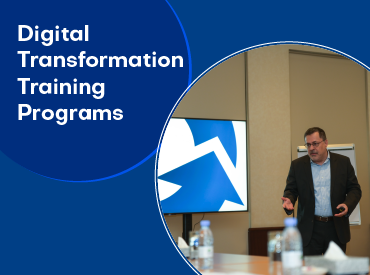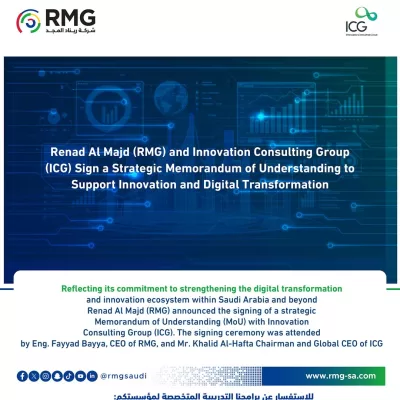Blog Body

The business world is undergoing a radical shift towards digitization, with digital technologies becoming a primary driver of growth, innovation, and competitiveness. Digital transformation is no longer just an option but a necessity for organizations seeking to survive and thrive in the digital age. It involves integrating digital technologies into all aspects of business, from internal operations to customer experience, aiming to improve efficiency, productivity, and strategic decision-making.

What is Digital Transformation?
Digital transformation is a comprehensive and integrated process that aims to strategically use digital technologies to transform operations, services, and business models within organizations. It is not limited to simply automating existing processes but includes rethinking how the organization operates and how it interacts with customers, suppliers, and partners.
Stages and Steps of Digital Transformation
The digital transformation process involves several interconnected stages and steps designed to achieve the organization’s goals through leveraging digital technologies. These stages and steps can be summarized as follows:

1. Strategic Assessment and Planning Phase
This phase is the cornerstone of successful digital transformation. It includes the following steps:
- Current Situation Analysis: This includes assessing the organization’s current state in terms of technical infrastructure, current operations, customer interaction, strengths and weaknesses, and opportunities and challenges. This involves analyzing available data, conducting interviews with employees and customers, and studying industry best practices.
- Vision and Objectives Setting: Defining a clear vision for digital transformation and its strategic objectives. The objectives should be Specific, Measurable, Achievable, Relevant, and Time-bound (SMART). The objectives should align with the organization’s overall strategy.
- Defining the Scope of Digital Transformation: Determining the areas and processes that will be included in the digital transformation. It is important to start with small, manageable projects and then expand gradually.
- Developing a Digital Transformation Strategy: Creating a comprehensive plan that outlines the steps, procedures, and resources required to achieve the defined objectives. The strategy should include selecting appropriate technologies, determining the budget, defining responsibilities, and establishing a timeline.

2. Implementation Phase
This phase involves applying the defined strategy and implementing digital projects. This phase includes:
- Selecting and Implementing Digital Technologies: Choosing the appropriate technologies that support the digital transformation objectives, such as cloud computing, artificial intelligence, the Internet of Things, big data analytics, and others. It is essential to ensure the integration of these technologies with existing systems.
- Process Improvement: Re-engineering and updating existing processes using digital technologies to improve efficiency, productivity, and reduce costs.
- Employee Training and Qualification: Providing necessary training and qualification to employees to use the new technologies and adapt to changes in operations.
- Change Management: Managing the change process effectively to ensure employee and customer acceptance of the digital transformation.

3. Monitoring and Evaluation Phase
This phase is essential to ensure the success of the digital transformation and the achievement of the defined objectives. This phase includes:
- Results Measurement: Measuring the performance of digital projects and comparing them with the defined objectives. Using Key Performance Indicators (KPIs) to measure progress.
- Data Analysis: Analyzing the data collected from digital projects to identify strengths and weaknesses and take necessary corrective actions.
- Continuous Improvement: Making continuous adjustments and improvements to digital projects based on evaluation results and feedback.

4. Addressing Challenges and Adaptation Phase
Digital transformation is a dynamic process that requires continuous adaptation to changes in technologies and the market. This phase includes:
- Identifying and Addressing Challenges: Identifying the challenges facing the digital transformation process, such as resistance to change, lack of skills, data security issues, and developing plans to address them.
- Adapting to New Technologies: Monitoring developments in digital technologies and adopting new technologies that support the organization’s objectives.
- Flexibility and Agility: Organizations must be flexible and able to adapt to changes in the market and customer needs.

Benefits of Digital Transformation
- Improved Customer Experience: Providing seamless and personalized digital experiences for customers.
- Increased Efficiency and Productivity: Automating processes and reducing costs.
- Better Decision-Making: Analyzing data to make informed strategic decisions.
- Increased Revenue and Profits: Developing new products and services and increasing market share.
- Enhanced Innovation: Encouraging a culture of innovation and experimentation.

Digital Transformation is More Than Just Technology
Digital transformation is not just about implementing new technologies; it is a comprehensive cultural and strategic transformation that requires careful planning, effective implementation, and continuous monitoring. By following the steps and stages mentioned above, organizations can leverage the power of digital technologies to achieve their goals, improve their performance, and stay ahead of the competition






























